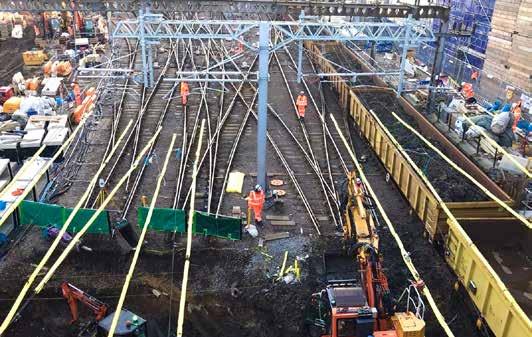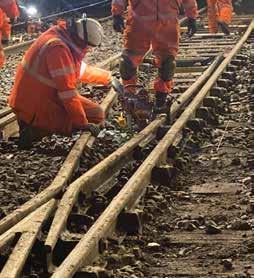
8 minute read
Clearing the throat and removing the hump
Clearing COLLIN CARR the Throat
and removing the hump!
Back in pre-COVID times, when life felt normal but hectic, Rail Engineer published an article about Network Rail’s plans to spend £1.2 billion upgrading the East Coast main line. It outlined a hugely ambitious scheme that has taken some time to plan and organise, coupled with an alliance of contractors capable of delivering all aspects of the project including the design, electrification and power plus the civils work. The newly-installed Line A at Belle Isle.
Camden Sewer works.



Detailed schemes have been developed for the King’s Cross station area, Stevenage station and Werrington junction, as well as the renewal of the overhead power supply to the main line from Edinburgh to London. Work started in earnest, on the ground in 2018.
Since then, 23 substations and more than 600km of new cabling have been installed along the route, as well as the construction of new foundations for structures designed to support the new overhead line equipment in order to ensure that the connection to the 400kV national grid is fitting for the future demands and resilience of the system.
Significant progress has been made. The disused Gasworks tunnel, situated on the approach to King’s Cross station, was cleared of 11,000 tonnes of spoil before installing Rhomberg Sersa UK PORR slab (STA) track. This change will offer two new tracks to King’s Cross with the potential to increase rail access to the station by 50 per cent, which is a significant development and milestone for the overall project.
Camden Sewer
All that now needs to be done is to re-model the station throat - a significant engineering challenge that is not an undertaking for the fainthearted. The project team was focused on this throughout the Christmas period as it formed one of the key challenges of the whole project.
Although the station has been completely revamped over recent years, the rail access to the station has not been changed for over 40 years and, just to add a bit more spice to the challenge, there is an old sewer - the Camden Sewer - that runs right across the throat at right angles, which needed to be replaced.
The Camden Sewer can carry up to 3,200 litres/second. It is old and there is only a shallow cover of around 200mm between the oval shaped brick and concrete sewer and the bottom of the sleepers on the track above. As a consequence, the vertical alignment of all the tracks has been compromised, creating a ‘hump’ across all the tracks, and there has been a longstanding 15mph speed restriction on all the tracks, designed to protect the sewer. This has meant that movements in and out of the station have been severely restricted, inhibiting train performance.
It was agreed very early on in the project that the sewer had to go, which is what turned everyone’s focus and attention on the King’s Cross station approach over the Christmas period.

Planned closure
After months of planning and preparation, a six-day closure of the station was agreed with the train operators, from 25 December until 30 December, after which there would be a reduced service from the 31st until 3 January 2021.
This would be the first time in 40 years that all four tracks leading into King’s Cross station were removed at the same time.
Rail Engineer spoke with Network Rail’s programme manager Mark Bell and project manager Jim Scholes, and with Marina Torres, sub-agent for principal contractor Morgan Sindall, about this challenging part of the East Coast Upgrade. Reconstructing Camden Sewer on approach to King’s Cross.
Old sewer being removed.

Teams reconstructing Camden Sewer.
Inspecting the re-laid trackwork above Camden Sewer. Pandemic
They explained that, throughout the long planning process, many options, opportunities and concerns were considered, but the thought of a global pandemic had not been one of them. The country was, and still is, experiencing constraints and restrictions that are unheard of in most people’s lifetime. Back in March 2020, a decision was made by Network Rail to stand the project team down for ten days, so that they could review all the plans and incorporate all the controls and constraints now required to ensure everyone’s safety in these strange and very difficult times.
Staff numbers were adjusted to accommodate social distancing rules. Processes and procedures were amended and a rigorous on-site COVID testing regime introduced. Following the review, it was agreed by all parties that all of the work that had been planned could be achieved.
The virus did impact on the project but, as Mark pointed out, adopting an effective ‘One Team’ attitude, underpinned by good discipline and commitment to the plan, enabled everyone, collectively, to control and manage the risks effectively.
These decisions impacted not only the team delivering the project but also the Thames Water Authority, which also had an important role to play with regard to maintaining an effective and safe sewage outflow.
By Christmas Day, the tracks had been removed at the entrance/throat to King’s Cross station, using a Kirow crane, and the Overhead Line Equipment (OLE) had been protected. More than 1,000 tonnes of spoil had to be removed to enable the construction of the new sewer, using 44 precast concrete units, each 1.2 metres high x 1.4 metres long x 0.5metres deep, across the throat, ready to meet up with 83 similar units that had been installed either end before the possession began.
Once installed and connected into the Thames Water system, the old sewer could be removed. Storm Bella
That all sounds quite straight forward. A wellprepared plan had been developed to remove the spoil, 450 tonnes by dumper to a road access and the rest by rail. Not an easy task but, with careful planning, eminently do-able.
What hadn’t been expected was the arrival of Storm Bella, which hit the site at 06:00 on 27 December. It brought with it continuous rain for nine hours, which is not ideal when digging a big trench across a major station complex ready for the installation of the base slab, designed to support the new concrete sewer units.
It is times like this when engineers are really able to show their worth and, following a quick review of the work, an effective, revised plan, prepared by Morgan Sindall, was approved by Network Rail and put into action. By significantly amending the original plan, the base slab was completed on time.
By 28 December, the construction of the new sewer was well advanced, making it possible to backfill the excavation with ballast and enable two tracks to be re-laid overnight. By the morning of 30 December, the OLE power supply was switched on over the two tracks now laid flat over the new sewer.
The final section of the sewer was installed early on New Year’s Day and the old sewer was broken up and removed. The Kirow crane reinstated the remaining tracks, switch heaters were reconnected, a vital component at this time of year, and the tracks were tamped and realigned with help from the local maintenance gangs to ensure a full service could be restored as planned on Monday 4 January.
The Camden Sewer took just nine days to be replaced by a new one and then demolished.
Whilst the work on the sewer was underway, the opportunity was taken to install essential OLE in the third bore of Gasworks tunnel, which is being brought back into use, alongside more than one hundred pieces of new signalling equipment as well as over 3km of cabling within the tunnel and elsewhere. Additional work was planned to waterproof key areas of the tunnel, helping to protect the new slab track and equipment that has been installed.

Improved track access
The southernmost platform, known as Platform Zero, has been demolished and is currently being realigned by Pod-Trak so that it lines up with the newly reopened third bore of Gasworks tunnel. There will then be eleven platforms, numbered zero to ten, designed to accommodate a new six track layout thus creating a fifty percent improvement to track access into the main shed of King’s Cross station. This could not be achieved without the removal of the old sewer.
The plan is to have all six tracks connected for commissioning by 7 June, alongside the reintroduction of the third bore of Gasworks tunnel to the system - a valuable asset that has been lying dormant for many years.
As part of the commissioning of the new layout in the station throat in April, signalling control will be transferred to York, leaving King’s Cross signal box redundant.
These are radical changes, all of which hinged on the successful removal of the old sewer. It will transform train movement at King’s Cross and it will be a major milestone for the East Coast Upgrade project.
But let’s just think back for a moment - the engineering team, working together, had spent months, if not years, preparing for this element of the overall scheme. Everyone agreed that the sewer had to go. Detailed plans were developed, then COVID-19 imposed its will on everything. Nothing was now guaranteed, and all aspects of the plan were suddenly vulnerable. Time had to be taken out to review the whole scheme. This involved everyone and required joined-up thinking, ingenuity, commitment, a strong nerve and, most importantly, a one-team approach.
Mark, Jim and Marina were justifiably pleased with their endeavours. More than 16,000 hours were worked on site and, despite a pandemic and a severe storm, the work was delivered on time. As Mark stated: “We are extremely proud of what we have achieved working as one team ready to take on the next stage planned for the end of February”.
A view happily endorsed by both Jim and Marina. (Above) Excavating spoil from Camden Sewer. (Inset) A final inspection of the overhead line equipment following the work at King’s Cross.














